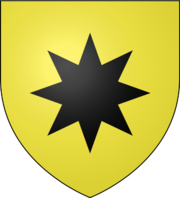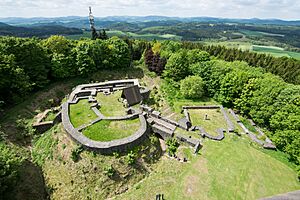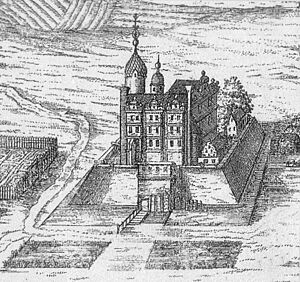Wolrad IV, Count of Waldeck-Eisenberg facts for kids
Quick facts for kids
Wolrad IV, Count of Waldeck-Eisenberg
|
|
|---|---|
| Count of Waldeck-Eisenberg | |
| Coat of arms |  |
| Reign | 1588–1640 |
| Predecessor | Josias I |
| Successor | Philip Theodor |
| Full name |
Wolrad IV Count of Waldeck-Eisenberg
|
| Native name | Wolrad IV Graf von Waldeck-Eisenberg |
| Born | 7 July 1588 Eisenberg Castle |
| Baptised | 4 August 1588 Eisenberg Castle |
| Died | 6 October 1640 (aged 52) Arolsen |
| Buried | St. Kilian Church, Korbach |
| Noble family | House of Waldeck |
| Spouse(s) | Anne of Baden-Hochberg |
| Issue Detail |
|
| Father | Josias I of Waldeck-Eisenberg |
| Mother | Mary of Barby and Mühlingen |
Count Wolrad IV 'the Pious' of Waldeck-Eisenberg (born July 7, 1588 – died October 6, 1640) was a German noble. He became the Count of Waldeck-Eisenberg in 1588. He also started a new branch of the Waldeck-Eisenberg family.
During Wolrad IV's rule, the independence of the County of Waldeck was greatly challenged. This was mainly by Hesse, a powerful neighboring state. Wolrad and his older brother, Christian, worked hard to keep their land independent. They used legal ways to protect their county. During the difficult Thirty Years' War, they chose to support Sweden. This was a smart move for them. However, neither brother lived to see the end of the war. They also did not see the end of the conflict with Hesse.
Contents
Biography
Early Life and Challenges
Wolrad was born at Eisenberg Castle on July 7, 1588. He was the second son of Count Josias I of Waldeck-Eisenberg. His mother was Countess Mary of Barby and Mühlingen. Wolrad was baptized at Eisenberg Castle on August 4. Just two days later, his father died suddenly.
Because Wolrad and his older brother Christian were still children, their mother and Count Francis III of Waldeck-Landau became their guardians. They also ruled the county until the boys were old enough. The reforms their father had started were put on hold. Other branches of the Waldeck family died out around this time. This meant more land and power came to Wolrad's family.
Protecting Waldeck's Independence
From 1604, when Christian started ruling, a big conflict began. This was about who truly controlled the County of Waldeck. After a powerful ruler named Louis IV of Hesse-Marburg died, his cousin Maurice of Hesse-Kassel inherited some land. Maurice changed his religion to Calvinism in 1605. He then tried to force this religion on Waldeck. He also put political pressure on the county.
Wolrad and Christian fought back. They made Lutheranism the official religion for all of Waldeck. Wolrad became an adult in 1607. In that same year, the County of Waldeck was divided between him and Christian. Wolrad received the northern part, including Arolsen and Rhoden. Christian got Wildungen, Waldeck, Landau, and Wetterburg. They shared control of the city of Korbach.
Both brothers continued their father's strong policies. After years of others ruling for them, they faced many challenges. They tried to modernize their county. They also tried to limit the old feudal rights that powerful nobles had. This caused many serious conflicts. By 1614, Waldeck was in a deep government crisis.
Joining Forces Against Threats
The biggest threat came from Landgrave Maurice of Hesse-Kassel. In 1615, he attacked the border town of Freienhagen. To protect themselves, Wolrad and Christian decided to join the Wetterauer Grafenverein. This was a group of smaller states that united against Hesse. Landgrave Maurice thought Waldeck could not join because of old agreements.
However, Christian had married Elisabeth, the daughter of Count John VII 'the Middle' of Nassau-Siegen. This gave them allies in the Wetterauer Grafenverein. Maurice was also John VII's son-in-law, which made things complicated. The conflict grew when Wolrad and Christian tried to gain full control over Korbach. This made Landgrave Maurice so angry that he invaded Waldeck.
Wolrad and Christian also had problems with Korbach itself. It was the most powerful city in their county. From 1610, they tried to control it more. They argued about who had the highest jurisdiction (legal power) in Waldeck. This led to a case in the Reichskammergericht, a high court. In 1619, a document was published that said Waldeck was directly under the Emperor. This showed how serious the situation was.
The Thirty Years' War and Its Impact
By summer 1620, Landgrave Maurice occupied most of Waldeck. Only Waldeck Castle and Arolsen remained free. Hesse wanted to take over Waldeck completely. But the Waldeck counts did not give up. The Wetterauer Grafenverein sent soldiers to help. These soldiers, along with Count John VII 'the Middle', were trapped in the castle.
Wolrad gained the support of Maurice of Orange, a famous military leader. This brought the Dutch Republic into the conflict. Christian tried to get help from Emperor Ferdinand II. Christian had once saved the Emperor's life during a hunt. The Emperor and others pressured Landgrave Maurice. In summer 1621, Maurice ended his occupation of Waldeck.
After this immediate danger passed, Wolrad and Christian continued their fight in court. They also demanded money for the damage caused by Hessian soldiers. In 1630, Emperor Ferdinand II ordered Landgrave Maurice to pay. A settlement was reached in Kassel in 1632. In 1624, Korbach finally agreed to the counts' authority. This helped calm things down in the county.
Waldeck even gained new land during these tough times. The County of Pyrmont became part of Waldeck. After Count Philip Ernest of Gleichen died in 1619, his brother Hans Louis ruled Pyrmont. Since Hans Louis had no children, he made an agreement with Wolrad and Christian. In 1625, he gave the County of Pyrmont to them. Hans Louis died in 1631. Wolrad and Christian officially became Counts of Pyrmont in 1630.
However, the Thirty Years' War brought terrible hardship. The Prince-Bishopric of Paderborn also claimed Pyrmont. In 1629, Prince-Bishop Ferdinand I occupied Pyrmont. He besieged Pyrmont Castle, forcing it to surrender. But in 1631, Christian met King Gustavus II Adolphus of Sweden. Waldeck then joined forces with Sweden. After Sweden won a battle in 1633, Pyrmont was returned to Waldeck.
Despite this, Waldeck's alliance with Sweden could not stop the suffering. Passing troops drained the county's resources. In the mid-1630s, the plague also broke out. Imperial troops took Pyrmont Castle again in 1636. Wolrad and Christian did not live to see it recaptured. Wolrad died in Arolsen on October 6, 1640. His oldest living son, Philip Theodor, took over as count.
Marriage and issue
Wolrad married Margravine Anne of Baden-Hochberg on September 8, 1607, in Durlach. Anne was born on November 13, 1587, and died on March 11, 1649. She was the daughter of Margrave James III of Baden-Hochberg.
Wolrad and Anne had the following children:
- Mary Elisabeth (born September 2, 1608 – died February 19, 1643). She became an Abbess (leader of a convent) of Schaaken Abbey. She married Frederick V of Baden-Durlach in 1634.
- Josias Floris (born July 23, 1612 – died February 1, 1613).
- Count Philip Theodor (born November 2, 1614 – died December 7, 1645). He became count after his father died in 1640. He married Mary Magdalene of Nassau-Siegen in 1639.
- John Louis (born November 20, 1616 – died July 17, 1638). He served in the Dutch States Army.
- Fürst George Frederick (born January 31, 1620 – died November 9, 1692). He became a Reichsfürst (Prince of the Holy Roman Empire) in 1682. He married Elisabeth Charlotte of Nassau-Siegen in 1643.
- James (born May 2, 1621 – died June 3, 1645). He also served in the Dutch States Army.
- Christian (born March 17, 1623 – died October 21, 1623).
- Anne Juliane (born January 15, 1624 – died August 20, 1624).
- Wolrad V (born November 25, 1625 – died January 29, 1657). He was a major general in the army of Brandenburg.
- Charlotte (born February 4, 1629 – died July 3, 1629).
Sources
|
Wolrad IV, Count of Waldeck-Eisenberg
House of Waldeck
Born: 7 July 1588 Died: 6 October 1640 |
||
| Preceded by Josias I |
Count of Waldeck-Eisenberg 1588–1640 |
Succeeded by Philip Theodor |
| Preceded by Hans Louis of Gleichen |
Count of Pyrmont 1625–1640 |
Succeeded by Philip Theodor of Waldeck-Eisenberg |



